
High Plains Gardening
The gardening website of the Texas High Plains Region
Pansies, ornamental cabbage and kale, along with showy purple mustard, color my garden in winter before bulbs and flowering perennials appear. Even now in the midst of winter, all is not quiet. Throughout every nook and cranny of the garden tips of bulb leaves push upward 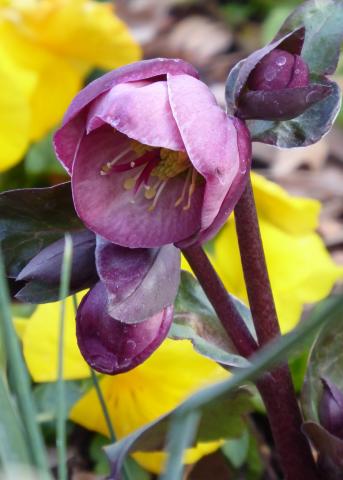 testing day length and cold.
testing day length and cold.
I will add my voice to the many who have written about the difficult year of the coronovirus pandemic of 2020. As I had more time on my hands and few places to go during the year of physical distancing, I spent even more time in the garden working and observing. My gardening year was filled with drama, delight and satisfaction.
My gardening year begins with winter cleanup in late January, on any sunny day with low winds and a mild winter temperature above fifty degrees. I used to call it spring cleanup, but my goal is always to have the leaves and dead stems cleaned up by the first week in March to properly appreciate the early bulbs – mainly crocus and a few early daffodils. Leaves are raked and mowed into small bits and put back on the beds. I have a red oak and an American sycamore tree, and the neighbor on the west side has a mulberry tree -- all with large leaves that fall and cover early flowers. (A view of the improved front garden in September at left.)
After two months of winter, on a gray day in the bleakest month of all, I suddenly lose hope that the garden will revive. I know it sounds silly, and that thought only lasts for a moment. My rational side reminds the emotional that our Earth’s journey will be like every other year. Day length will increase and temperatures will gradually warm until roots in the soil are stirred into action and green growth is seen everywhere. (Hellebore 'Tutu' at upper right in January.)
The first few weeks in the garden are spent tidying up for the show to come. This makes it sounds like I go around picking up a few socks and straightening pictures in a leisurely fashion. After three months of wind and snow, the entire garden needs attention. The spring cleanup is nasty, dusty and hard work on the joints and muscles used to sitting around the house drinking tea and eating cookies.
If all the fallen leaves would have fallen into the center of the lawn and stayed, it would be an easy task to hoover them up with the mower. As most of us with fenced back gardens realize, the winds swirl not just the snow, but leaves, into the borders that line the perimeters next to the fence.
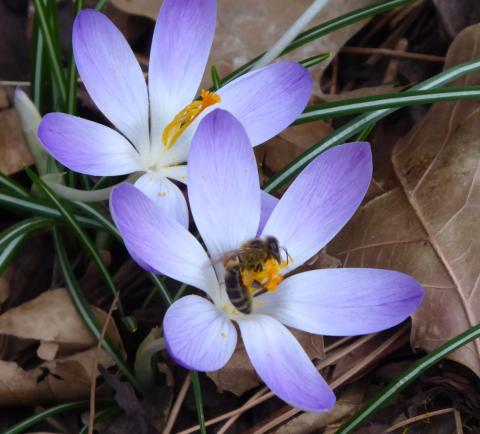
It’s a slow, tedious job raking, often with a hand rake, between the stems of shrubs and woody perennials. The raking is interrupted by pulling out the pruners to cut off dead stems of the herbaceous plants. But worst of all, it’s a dusty job. I sigh, and sometimes laugh, when I watch English gardening shows with gardeners wearing wellies up to their knees walking ankle deep in mud. Not here at all, ever.
Each year the gardener is rewarded by noticing the first tiny flower of the year as she rakes between plants. In the spring of 2018, I finally planted four hellebore plants, after thinking about it far too many years. I noticed few flowers in 2019, but by January 20, 2020, the first flowers began to appear. As most gardeners can appreciate, early flowers breaking through in the bleak months of January and February when prospects for the gardens of our imagination seem dim, provide a good deal of hope for the gardening year.
Blooming progress was slow, but by mid February the first crocus, Crocus tommasinianus ‘Lilac Beauty’, was seen (shown at right), soon to be followed by C. vernus ‘Flower Record’ and the lovely striped ‘Pickwick’ towards the end of the month. I noticed honey bees ending their slumber on warm sunny days visiting them, something I hadn’t taken the time to see in past years.

March blooms start slow, with more crocus and many more hellebore flowers on several of the plants, especially the ones in sunny locations. I planted two in a north facing shaded bed that took several weeks longer to bloom. A hellebore with reddish bronze leaves and pink flowers I think is ‘Tutu’ seems to be the strongest. The earliest daffodils to greet me are Rijnveld’s Early Sensation and Lemon Glow, purchased in 2000 – 2001. These for years have opened by the second week in March, in some years at least a week or ten days earlier. This February was nearly two degrees colder than average, so they bloomed when expected. Planted up against the house, warmth from the south facing bricks sped their bloom, causing me to cover their visible buds when a colder cold front rolls through – it’s most distressing to have them freze, as can happen. Now I buy only later blooming daffodils to avoid this weather stress. I dug most of them up last year and replanted in other places, so as not to give them this heat advantage.
Many other daffodil varieties continue to open, as well as hyacinths in the second and third week of March, and species tulips, beginning to open by the end of the month. Of the hyacinths, my favorite is H. orientalis ‘Woodstock’, a deep maroon, as I am drawn to red colored flowers, especially in the spring when there are so few. I've had a clump of ‘Delft Blue’ for many years in a back border. I find hyacinths to be quite consistent and long lived. Their fragrance pleasantly carries throughout the back garden, noticeable as I go about the gardening tasks. It is no wonder to me that hyacinths enjoyed a mini-mania of their own, about a hundred years after the great tulip mania of the 17th century. I should probably plant more.
Many of the bulbs in the tulip bed are opening. Fritillaria’s (species uva-vulpis) graceful unfurling catches and holds my interest as I work and walk back and forth, planted as it is on the edge of the bed so I wouldn’t miss it.
Accompanying the bulbs, the Mahonia shrub borders burst into fragrant yellow flowers. First to open are the shrubs in full sun, then those on the south side of the backyard shaded by the fence. Creeping Oregon grape holly, as it is known, has long been one of my top ten plants (native, evergreen with four seasons of interest).
Non-native spring blooming bulbs make up the majority of early spring flowers. I made the decision to include them in my garden for the simple reason they bloom earlier than most other plants. We cannot grow red-twig dogwood, camellias or witch hazel for winter interest due to our alkaline soil. And our climate of rapid temperature shifts that bring cold Arctic air and snows even into the first week in May, forestalls the blooming of many natives until May. My xeric garden areas don’t come to life until mid to late April. Species tulip, muscari and any of the small spring bulbs thrive in xeric areas until California poppies, blue flax, calylophus and Missouri evening primrose are stirred to bloom at the end of April.
March was truly splendid with many of the bulbs and hellebores in full flower, but the garden ascends a notch in April. April is my Tulip month. It’s an exciting time in the garden, front and back.
Now all the species tulips planted in the xeric beds begin opening almost overnight -- Tulipa clusiana “Peppermint Stick’ (photo at left) makes a strong pink and white stand, its clump grows larger each year. (Note to self, time to divide.) T. clusiana chrysantha and ‘Cynthia’ are also strong, reliable performers. Tulipa kolpakowskiana, a very small (4 inches tall) tulip blooms yellow, and just for us, as there are too few, are too short lived, and too small to be seen from the street. I planted it where Veronica ‘Blue Reflection’ has spread and blooms at the same time -- a pleasing composition. Last fall I added a scant winding line of T. praestans ‘Shogun’, a short orange tulip planted in the bed opposite the xeric strip where nothing else yet bloomed. Only a few short short red T. whittallii were planted among the yellow and orange T. chrysantha for sparkle. I have tried some of the earlier blooming T. humulis ‘Persian Pearl’ and T. linifolia in the past, but they made only one appearance.
Along the west side of the house, the shrub, pink flowering almond, blooms. Beneath it, the last few twinkling blue flowers of Vinca minor peak through their shiny dark green leaves, along with scattered groupings of species T. ‘Cynthia’. On the east side, I planted a ‘Lynnwood Gold’ forsythia . I only like it one time of the year, when it shines as bright as the sun in April. ‘Magical Gold’ forsythia is planted in a shady spot in the back along the west fence. I have never seen it with more than a few flowers; I’m sure it’s too shady a spot.
As far as species tulips in the back garden, T. sylvestris (see at right), a yellow woodland tulip with curling outer petals, turned out to be a star performer, and if I decide I can squeeze any more bulbs into these beds, this would be my first choice. T. orphanidea flava was described lovingly in books and articles, but turned out to have a great disappearing act in my garden. Alas.
The main tulip bed is filled with hybrid tulips -- much more familiar to most than are the species tulips. Or should be filled. Instead it was filled to overflowing with daffodils and what I hoped would be a second year of flowering, after a thrilling debut in 2019, that of the “world’s most popular tulip” Darwin hybrid ‘Apeldoorn’. You might recall, we had an unusually wet spring in 2019. I don’t know if this was the cause of the ‘Apeldoorn’ tulips’ demise, but they did not re-appear. Which was surprising, as I had grown a clump of Apeldoorns for enough years for them to be classified as heirloom. Regardless, a scant few lived through along with the many daffodils planted in the bed. Purple double late tulips filled a pot topped with pansies and an east side bed of pink lily-flowering Mariette tulips helped console me. Grape hyacinths, Muscari paradoxum and armeniacum, and Leucojum join the chorus all too briefly.
Spring Weather Drama
Once more in April, I suffered from weather stress when mid month a snowstorm blew across the Plains. All gardeners are weather watchers, so I hurriedly lugged all the pots that shouldn’t take a freeze back into the shed, and trays of plants bought too early into the house. I deemed the tulip bed too large to cover, but many areas were covered, including individual plants of Allium christophii, ‘Star of Persia’ that had just begun to bloom. It’s quite a glamorous allium, short (18-24”) with large 8” globes of amethyst-violet (really pinkish, in
common language) metallic star shaped florets and long blooming. I would like to fill my garden with them everywhere—no, I must practice restraint. I wasn’t able to cover all them. Not to worry, those uncovered fared just fine from this cold assault, as did numerous bulbs of Allium ‘Purple Sensation’. Both these ornamental onions add late spring interest and are said to attract bees. I covered many of the iris in bud, but the cold stunted their flowering along with the iris not yet showing buds. Both the coral bells and columbines, which because of early warm weather, had begun to bud, froze back. I was able to cut one bouquet of lilac flowers just before the cold. Similar to last year, the remaining flowers were killed. Tulips and daffodils had their flowers in full bloom weighed down to the ground with 2 inches of snow, thankfully popping back up unharmed when it melted the next day.
Pots and trays of plants are brought back outside to enjoy the warmer weather and the sun. Perennial plants in the xeric bed, undaunted by the snow and cold, began to open. California poppies, blue flax, prairie verbena, prairie zinnia, chocolate flower, gaillardia, Santa Fe phlox and Missouri evening primrose joined Nepeta ‘Select Blue’ already blooming. These were joined shortly by Salvia greggii ‘Furmans Red’, as it needed to recover a bit from the cold.
In the shady borders, coral bells put on new leaves. Brunnera, an early flowering silver leafed plant known as heartleaf, was unaffected by the cold. By the first half of April, splays of sky blue flowers appear above the plant on thin stems.
April is a feverish time for both the garden and gardener.
At the first of May, sulphur flower, Erigonium umbellatum, shone bright with golden yellow flowers. Beside it, a few blue Ixiolirion bloomed side by side purely by chance. This small bulb with grass-like foliage is worth more space if only I had it to give. As is the case for another bulb with grass-like foliage, star flower Ipheion ‘Wisley Blue’; a small clump has grown for years in the back garden. If I only had more space . . . .
By May it was clear our travel plans are canceled by the coronovirus pandemic. Two beds were in need of a new composition and soil amending, as it had been many years since I initially amended. (Photo at left is the xerstrip just breaking into flower, and to the right, Allium 'Purple Sensation' under the smoketree.)
In the back, one of my first xeric borders was in sad shape. As the years passed and the red oak grew tall, more and more shade fell upon it and few plants remained from its early days. My soil is compact clay, and this bed certainly had used up any organic matter previously added. Little wanted to grow.
I stepped up my pace if I was going to finish before the weather became summer hot. Some plants were removed and saved and both organic and inorganics worked into the soil to provide good drainage. I had a group of volcanic rocks, and decided to make a seascape garden, to imitate the look of a seabed floor from a Sunset magazine photo I’d seen years ago. Though on a much smaller scale than the seascape at Quail Botanic Garden, I had a lot of fun looking for succulents that would fit the look. I divided sedums and used semperviven pups I’d grown the previous year in addition to the succulents. (Photo of seascape lower left.)
Mock orange Philadelphus × virginalis 'Natchez' blooms around mid-May. It was purchased many, many years ago because of its strong orange fragrance. I must have gotten the one with the mild fragrance, as I have to put my nose up close and inhale deeply to smell it. And as a resource said, it looks scraggly most of the year, except for the two weeks in bloom. Nandina, planted along the west side by the fence and a few other shaded areas, bloomed with small white flowers, promising red berries for the winter season. I have to remind my self to look for the flowers, as I am now in a race with time.
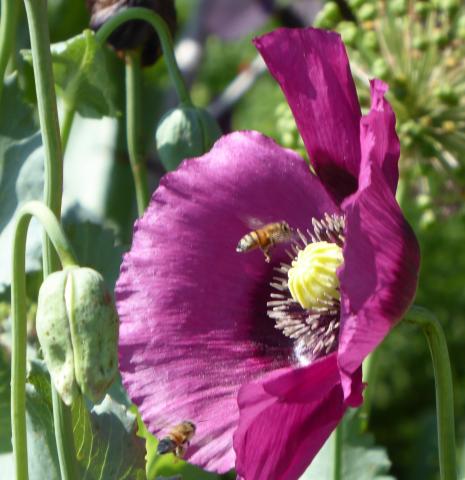
The seascape completed, my attention quickly turned to the sunny border at the front of the house facing the sidewalk, opposite the xeristrip. Last autumn I finally decided the bed had a disorganized look and longed for better plant composition and soil amendment. I had long thought of this front bed as a three seasons of interest bed culminating in a brilliant fall garden. Last year I learned from Gertrude Jekyll that a single border cannot contain everything. Further, according to Ms. Jekyll, “To plant and maintain a flower border, with a good scheme for colour, is by no means the easy thing that is commonly supposed.” Her advice helped me to see this border clearly for the first time. I gave up on the struggle for three seasons of interest and devoted its development for a late summer to fall display.
I dug in, literally. Plants were re-purposed, given away, or thrown out. For a number of years I had divided twist leaf yucca, Yucca rupicola, and replanted them to containers. Using this non-invasive southwest evergreen, I planted a ribbon of them throughout the front bed. A color scheme in shades of purple and blue, with an accent of yellow flowers was planned. Additionally, the plants added were intended to support bees and butterflies. Purple Salvia greggii and a purple form of the long blooming Scutellaria suffrutescens were added. Salvia neomexicana; Salvia incana; 'Rose Marvel' salvia, Salvia nemorosa; aster Symphyotrichum oblongifolium ‘October Skies’; and ‘Fireworks’ goldenrod were added to Boltonia and Gregg’s mist flower, Conoclinium greggii. I’ve grown purple vervain, Verbena bonariensis, for several years, and kept it, spreading out the few baby seedlings I found to increase its area.
As I planned and planted, the iris bloomed, though not as robustly as most years. A succession of purple flowers graced the front bed under the ‘Royal Purple’ smoke tree including ‘Purple Sensation’ and drumstick ornamental onions, ‘Lauren’s Dark Grape’ poppies (pictured on the right) along with annual larkspur in pink, white and blue. I have finally gotten to the point in my gardening where I can do color coordination. Texas red yucca and Yucca pallida bloomed in other parts of the front garden, and an arborescent Yucca rigida bloomed tall in the back. All the non-bulb plants mentioned in the xeric garden continued to bloom, as did a few penstemon.
I am still tinkering with the border that fronts our home. I took out many plants that had spread beyond there territory and amended the beds in 2018-2019. This year, I thought an edging of bedding dahlias would be the ticket. I didn’t count on the length of time it would take for them to begin blooming – into August! I was hoping the dahlias would be beneficial to pollinators, however, it wasn’t until October that they attracted any. Disappointing. I will try afresh this spring with something different.
In the back garden, the columbines recouped after the April freeze and put on a glorious show; I needn’t have been worried. Flowers from the coral bells were much less plentiful than last year.
The first part of the gardening year came to a close at the end of May. The weather, as it does, alternated between warm and cold windy days. It was a dry spring overall.
June brought hot sunny days, and a seemed a dry summer. A summer filled more of the expectation, than the actual rain.
I was ready to sit back with time for relaxation and observation. But I was not quite finished.
Summer heat truly settled over the garden. Daffodils, hyacinths and any remaining tulips bulbs from the tulip bed where dug up, cleaned and stored in preparation for the summer caladium bed. I conceived this new summer planting scheme for the tulip bed the previous year and placed an early January order of 30 jumbo size caladium tubers from Florida Boys Caladiums, In April, they were potted in individual pots and placed in the sun to sprout while the bulb foliage died down in the tulip garden. At the same time, caladium tubers held over from the previous year where planted in containers. By the first week in June, little shoots had just begun coming up. In they went in the tulip bed, now shaded by a nearby locust tree. (Two photos on the left of tropical plants in containers in the sunny front garden, bougainvillea and hibiscus.)
Throughout the growing season, different aspects of my garden pulls me from the sunny front to the shady back. The seascape garden drew my interest as all the plants responded well to the newly amended soil. Week to week I watched them grow. This was mainly a foliage bed with few blooming plants. It would be autumn before certain sedums and rain lilies flower.
In the front garden, purple vervain grew and bloomed, remaining in bloom until the first freeze in October, as did the echinaceas. I had planted a grouping of Salvia ‘Mystic Spires’, a Salvia farinacea hybrid. Known to be a vigorous grower, it grew halfheartedly throughout the summer, until it was sharply cut back in early September. It behaved like a new plant after that, shooting up and out, attracting all manner of bees, moths and butterflies.
A grouping of yellow daylilies, ‘Buried Treasure’ (photo above right) was a cheery spot for a solid month of June in the front border near the house. In flower near it were two Asclepias tuberosas’, butterfly weed plants. Strangely, I never noticed butterflies on them all summer. A gaura also bloomed adding an airiness to this corner of the bed. The new plants in the front border opposite the sidewalk, the purple and blue bed, quickly settled in and began their long period of bloom. A stunning cherry red bougainvillea and tropical hibuscus in containers brought additional color to the front of the house. 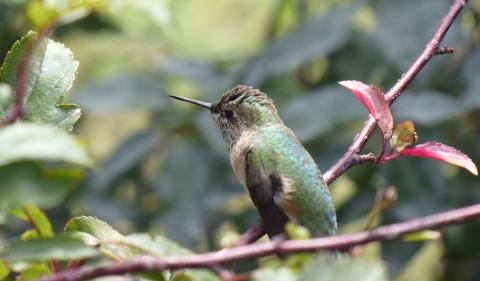
By July 4th, the caladium bed was beginning to look like a caladium bed. I had chosen the large, fancy leaf varieties ‘Pink Illusion’, ‘Pink Cloud’, and ‘Florida Elise’. In the center of the bed grew, though not as tall as I wanted, an elephant ear, Colocasia esculenta. However, they blended well together and I was happy with the investment.
This was the third year for my container of Abyssinian banana or wild banana, Ensete ventricosum 'Maurelii', wintered over in the shed. The leaves shred, first with the colder May winds, then in the hotter summer winds, but I love it anyway. This year I stuck a few carryover white caladium tubers around it. Not bad.
Besides the caladium containers, two other pots with elephant ears, both Alocasia (upright leaves) and Colocasia (downward leaves) formed a tropicalisimo groupings (photo at left). Another pot of tropicals and houseplants resides on the back patio.
Here at mid summer, I was rummaging in my shed and discovered a few small shriveled up Caladium tubers about the size of my thumb. I shoved them into a pot, and before two weeks were past, shoots and leaves were visible. Excellent! Over the years, I’ve developed a keen interest in foliage as plants of interest in the garden. It started with non cold hardy agaves, totem pole cactus, a golden barrel cactus that has twice outgrown its container, a leatherstem Jatropha I simply adore, and candelillia. These I group in the one sunny and hot area of the back garden.
Lately I’ve added tropicals in containers (both front and back), as they are friendlier to the gardener. Growing them in containers requires no more water than most container plants. Tropical plants have become a major part of my interest in mid summer when most flowering plants take a rest.
Back in the front garden, in July, flame acanthus begins to bloom by mid-month. Flame acanthus, Anisacanthus quadrifidus ssp. wrightii, has been a reliable mid-summer to frost bloomer for two decades. I have let it spread to several locations in the xeric beds (it does seed around, but is not invasive). I had thoughts of reducing their number, until I noticed they acted as flags to wave down hummingbirds. Only in the last few years, as I have had time to observe the sunny front garden from the front porch, have I noticed a pair of hummingbirds that frequent flame acanthus. They don’t visit every day, but several times a week. I love to watch when they both are present at the same time and in play. If persistent in standing out at midday, camera in hand, they seem to adjust to my presence and allow me to approach up close for a good photo. I don’t impose on them in this manner more than once or twice a summer.
There are two exciting times in the garden each year, mid-March through mid May in the back garden, and end of July through to frost in the front. Not that the summer tropicals in the shady back don’t interest me, they very much do. (Caladium bed on the right at the height of its brilliance just before Labor Day.) But the front sunny garden is composed to invite bees, butterflies and hummingbirds and there is a lot of activity most days. Boltonia, with their tiny, white, daisy-like flowers, open attracting bees; purple vervain, Gregg’s blue mist flower and coneflowers (echinanceas) become a butterfly hub and the zinnias start attracting pollinators too. The front garden becomes very active. (Pair of Painted Ladies on echinacea, purple vervain in the background.)
I marvel how our warm season native plants can thrive so when our temperatures are at the hottest and often, the driest. Xeric beds are irrigated once a month, if we hadn’t received an inch of rain within 30 days. The main front bed is irrigated every other week. Plants placed closer to the lawn will receive weekly irrigation during average summer conditions, more if it’s hotter.
By August, crepe myrtles bloom. A pair of white crepe myrtles flank the front corners of the house. Most years they look like shrubs, in warmer period of years they will appear tree form, as they had for quite a while. However, they froze back in October 2019 with those untimely October snow storms. This spring many shoots came up. I allowed the thickest trunk to remain from previous years and removed the suckers every few weeks for a pollard-ed look. I think I like it.
The flowering, buzzing and humming continues apace, interrupted somewhat on cloudy days, I noticed. In June, black swallowtail butterflies where seen flying front to back garden. In July, Painted Ladies came in numbers, and the odd Monarch. Dragonflies and bees were ever present.
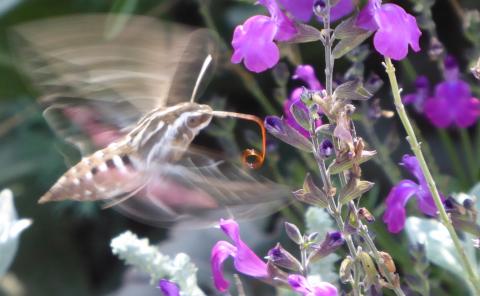 September and Weather Drama
September and Weather DramaTemperatures, both daytime and evening, cool considerably after Labor Day. The garden breathed a huge sigh with the relief of cooler weather. White rain lilies, Zephrantes candida, (photo at right)bloomed both front and back. (White-lined sphinx moth and purple Salvia greggii.)
In a surprise move, immediately after Labor Day, you might recall, September 9th and 10th, our area suddenly experienced daytime highs of 42 and 52 degrees F, and nighttime lows of 40 (on the 8th), 37 and 40 degrees F., a drastic departure from highs of the nineties immediately preceding. I moved tropicals inside for cover, and set up my double tunnel system over the caladium bed to save them, as they prefer temperatures above 55°. Fleece covers were thrown over the seascape to save the tender succulents I hoped to dig up later and store over winter.
This cold snap reminded me of the late snow in April, where I scrambled to take in pots and cover beds. My efforts were helpful, but this deep cold snap diminished the plant’s ardor across the garden. The caladiums came out of it OK, however, their spirit was broken, and a markedly visible decline set in much sooner than it should. In the sunny front garden, the plants went into a short reset period. Zinnias, ragged and worn, seemed to be the most affected, they never looked as good again, and took nearly four weeks to attract butterflies once more. The dahlia border seemed unaffected.
Within two weeks, fall blooming sedums, goldenrods, asters and blue mist spirea (Caryopteris) bloomed, along with dotted gayfeather, Liatris punctata, a local native. Dotted gayfeather, or dotted blazingstar, is said to be an excellent cut and/or dried flower, but I have never dared to deprive the many bees and butterflies that “dot” the flower stalks illuminated with purple flowers. I could be seen many afternoons watching the action. (Reworked front garden in September, photo at right.)
The early cold snap intensified feelings of fall. Pumpkin and gourd displays sprang up, front and back.
Some time after mid-September I noticed the Painted Lady butterflies looked different. Yes, upon much closer examination, American Ladies have joined as well as several Monarchs. Small, local butterflies (for more information, click here http://www.highplainsgardening.com/local-butterflies) joined the fray.
One would think a gardener could continue to relax and just enjoy the warm, calm days of autumn. Not so. October is a busy month as this is a month of change in the garden. (The autumn garden with monarch, photo at left.)
Blooming in the front garden continued in October. Now the zinnias were back in action. The pollinators sensed shorter day lengths too, they must stock up. Every flower of all the species were frequently visited—an actual feeding frenzy! Really, it was quite an amazing sight, butterflies, moths and bees vying for the same nectar. Bees and butterflies fed on all the usual plants, plus B & B’s on the salvias, B & B’s on flame acanthus, on sedums, on bougainvillea, on lantana, on the dahlias – unusual since no insects liked them previously. Chrysanthemums were the last of our flowers to open.
The first week of October also signaled it’s time to turn the caladium bed back into a tulip bed. I dug up the now-limpy looking caladiums; cleaned, dried and stored the tubers for next year. I know I can reuse them and they’ll grow just fine. They need to be dug up before night time temperatures fall to 45° to overwinter in storage. (Photo of echinaceas with butterflies at right, looking ragged after the early September cold snap.)
A new selection of tulip bulbs (single late varieties) and the best of the daffodils, and other bulbs were replanted. Pansies were planted over the top for winter color and a few containers where changed out with purple mustard, chrysanthemums, pansies and ornamental cabbage and kale.
Lingering from a planting in 2011 is one lone flower from a fall bulb, Sternbergia lutea, called the autumn daffodil, even though it looks more like a crocus. I would have had three if not for the snow. Two autumn white Crocus speciosus albus bloomed as well, from a few dozen planted then.
And so the growing season continued until October 23rd, coming to am abrupt end with a severe and prolonged cold (low of 18°) and snow (7.4 inches!) that hung on for 5 days or more. Cold sensitive xeric and tropical pots were taken into the shed once again and tender succulents from the seascape garden were dug and stored in preparation for the storm and winter to come. Our first freeze is usually mild, touching down to 31° for a few hours in early morning a number of times over a period of weeks until a season ending hard freeze arrives. Not this year. This was it, the end of the growing season. Over, it seemed, in a flash. No lingering fall spent enjoying the angled rays of sun on calm days, watching the leaves turn color and fall. (Photo at left of Salvia, 'Mystic Spires' loaded with bees before the October snow.)
I thought it devastating. One had become accustomed to lazy warm fall days extending almost to Thanksgiving. After this, the only flowers to remain were the pansies I had just planted – only two weeks previously. Not only did not any other flowers remain, the heavy snow crushed many of the perennial stems and ornamental grasses. Swirling wind patterns in the fenced back garden caused a foot of snow to bury the pansy bed, injuring many. After having my best pansy season last winter, this one looks poorly indeed.
Nandinas normally don’t drop their leaves until April, then regrow them quickly in May in our climate. However, this year, they fell with the cold in October. I had purchased a new nandina for a pot; it lost all its leaves, I hope it is still alive. Two cold hardy agav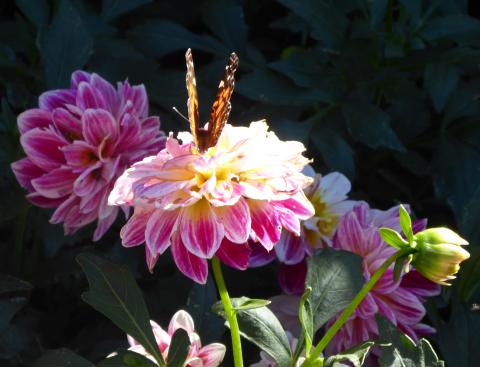 es in containers ringed with sedums died. An agave planted last fall was severely frozen back, but not killed. In my forgetfulness I neglected to shelter or protect them. Not thinking they would be harmed, I left exposed a container of beautifully formed ornamental kale on the back patio. They froze and were replaced. (Butterfly on dahlia at right just before the October snow.)
es in containers ringed with sedums died. An agave planted last fall was severely frozen back, but not killed. In my forgetfulness I neglected to shelter or protect them. Not thinking they would be harmed, I left exposed a container of beautifully formed ornamental kale on the back patio. They froze and were replaced. (Butterfly on dahlia at right just before the October snow.)
The garden lies dormant, cleanup and renewal awaiting a warm, sunny, calm day in January when I hope to notice the first flower. My year in the garden was book-ended by sudden shifts in weather. Not necessarily unusual. However, this year’s weather events defined the season more clearly than I can remember.
Shortly after the snow melted from the pansies, a lone remaining Painted Lady butterfly sipped nectar from a pale yellow pansy (photo below left). A sure signal that the cycle of life in the garden continues for another season.
Just as with any corporate year end audit, there are lessons to be learned and reinforced from reviewing the year’s notes and photos.
Chiefly, I resolve not to buy cold-tender plants like peppers and basil until mid-May. The past few years I’ve purchased them far too early and they’ve been damaged by cold spring temperatures dropping below 50 degrees. In our climate of rapid temperature shifts, the Amarillo area is not assured of sustained warmth until after Mother’s Day in May.
A gardener may win by pushing the seasons from time to time, certainly not always. I cannot recall one growing season being exactly like any other one. We might expect since our climate is warming, each year will be progressively warmer; regardless, untimely cold fronts will still descend from the Arctic.
Hellebores are my new darling of the early spring garden. If there is a plant you want to try, don’t wait for as many years as I waited to plant hellebores.
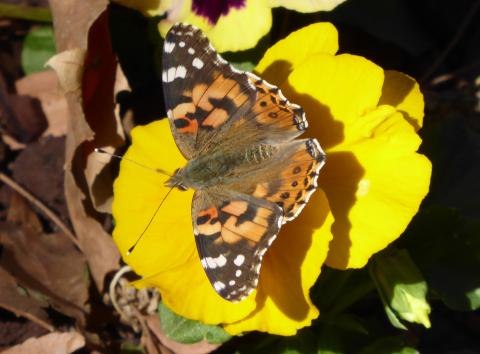 Trying new solutions for beds can be fun. The summer caladium and seascape beds will be repeated this coming year, if not enlarged. I wasn’t satisfied with the bedding dahlias, so a new scheme will be tried. And another area where I hoped to grow easy care succulents turned out to be a bit too shady. Gardening is all about problem solving. One constant gardeners everywhere will always be faced with are weather induced failures – there is no perfect climate anywhere.
Trying new solutions for beds can be fun. The summer caladium and seascape beds will be repeated this coming year, if not enlarged. I wasn’t satisfied with the bedding dahlias, so a new scheme will be tried. And another area where I hoped to grow easy care succulents turned out to be a bit too shady. Gardening is all about problem solving. One constant gardeners everywhere will always be faced with are weather induced failures – there is no perfect climate anywhere.
As I write this I am reminded of the introduction to Through the Garden Gate, written by one of America’s great gardeners and garden writers, Elizabeth Lawrence, where she invited readers in through the gate of her garden, to enter into her “world of mystery, adventure, and romance; . . . a world of beauty, and a world of work" She further advises, "Any garden demands as much of its maker as he has to give. But I do not need to tell you, if you are a gardener, that no other undertaking will give as great a return for the amount of effort put into it.”
All in all, it was a magnificent year in the garden, filled with thrills and travails, anxiety and marvels. I can’t wait to experience another year in the garden.
Angie Hanna, January 7, 2021